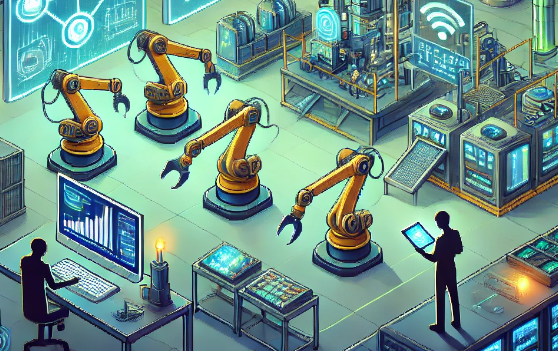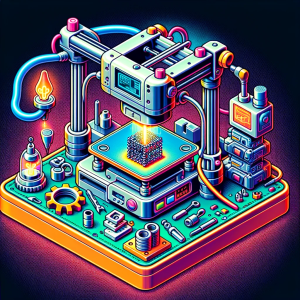
IoT Potential in Manufacturing
Imagine walking into a factory where machines talk to each other, sensors predict failures before they happen, and energy efficiency is no longer a dream but a reality. This isn’t science fiction; it’s the transformative power of the Internet of Things (IoT) in manufacturing. But here’s the catch—while the potential is vast, many manufacturers face steep hurdles in adopting IoT. A recent study reveals the key challenges and offers a path forward, not just for Bangladesh but for manufacturing worldwide.
The Promise of IoT: Beyond Gadgets and Gizmos
IoT is more than smart gadgets; it’s a paradigm shift for manufacturing. Picture a production line where machines not only perform tasks but also share real-time data, ensuring seamless operations. Think about supply chains so transparent that every component’s journey, from raw material to finished product, is trackable at the click of a button.
This isn’t just efficiency; it’s survival. In today’s cutthroat global market, manufacturers must innovate or risk falling behind. IoT offers predictive maintenance to prevent costly downtime, automated quality control to ensure perfect products, and even real-time environmental monitoring to create safer workplaces. The possibilities are endless—but so are the challenges.
Facing the Giants: Top Barriers to IoT Adoption
Despite its promise, adopting IoT isn’t easy. According to a recent study combining expert analysis with advanced fuzzy logic, three barriers stand out:
- Lack of Top Management Commitment
Without buy-in from leadership, IoT initiatives rarely get off the ground. Leaders hesitant to invest in new technologies risk stagnation, leaving their businesses vulnerable to competitors. - High Initial Costs
IoT isn’t cheap. From hardware and software to training and integration, the upfront costs can be daunting, particularly for small and medium-sized enterprises. - Risks of Changing Business Models
Transitioning to IoT often means overhauling traditional processes. For many manufacturers, the fear of disrupting what works—even imperfectly—keeps them stuck in the past.
These challenges demand immediate attention. But overcoming them requires more than identifying the problems—it calls for strategic, targeted solutions.
How Manufacturers Can Take the Leap
Leadership is Key
Convincing top management to support IoT initiatives is crucial. Case studies from industry leaders like Siemens and General Electric show that executive buy-in leads to transformative results. For instance, Siemens uses IoT for predictive maintenance, saving millions annually. Sharing success stories can inspire hesitant leaders to embrace change.
Think Big, Start Small
High costs shouldn’t deter action. Instead of a full-scale rollout, companies can start small—perhaps a pilot project on one production line. Demonstrating ROI through targeted initiatives can build confidence and justify further investment.
Education and Training
IoT’s technical complexity can be intimidating, but training programs and partnerships with tech providers can bridge the knowledge gap. Empowering employees at all levels ensures smoother integration and reduces resistance to change.
Collaboration is Power
The lack of standardization in IoT solutions is a hurdle, but collaboration among manufacturers, tech companies, and policymakers can establish industry-wide standards. In Bangladesh, public-private partnerships could provide the resources and expertise smaller firms need to compete globally.
Real-World Wins: IoT in Action
General Electric: Supply Chain Transparency. GE leverages IoT to monitor its supply chain in real time, reducing inefficiencies and improving demand forecasting. The result? Lower costs and happier customers.
Siemens: Predictive Maintenance. By embedding sensors in machinery, Siemens anticipates breakdowns before they occur. This approach minimizes downtime, saving time and money.
These examples demonstrate that IoT isn’t just an aspiration—it’s a practical tool driving real-world success.
Why This Matters Now
The urgency to adopt IoT is clear. Global competition is fiercer than ever, and manufacturers who hesitate risk falling behind. In Bangladesh, where the manufacturing sector is a cornerstone of the economy, embracing IoT could be the key to achieving Vision 2041’s goals of economic transformation.
But the implications stretch far beyond one nation. This study’s insights provide a roadmap for manufacturers worldwide, offering strategies to overcome barriers and unlock the full potential of IoT.
Join the Conversation
- How can smaller manufacturers balance the high costs of IoT adoption with the need for innovation?
- What role should governments play in helping industries embrace IoT?
We’d love to hear your thoughts—share your ideas in the comments below and join the discussion on this vital topic!
Explore and Learn with Science
Dive into groundbreaking research and inspiring stories with ‘This Week in Science’! Perfect for teachers and science enthusiasts, our free weekly newsletter expands your horizons in teaching and learning. Join us today and reshape your engagement with science. If you liked this blog, please share it! Your referrals help This Week in Science reach new readers.



